Early Childhood Recycling & Composting
VerifiedAdded on 2020/03/02
|18
|3447
|173
AI Summary
This assignment delves into the crucial topic of recycling and composting within early childhood education. It outlines various learning activities designed to engage young children in understanding these concepts, including rhymes, songs, and discussions about the three-bin system. The assignment also explores practical applications like vegetable gardens and worm farms, encouraging sustainable practices in a fun and interactive way.
Contribute Materials
Your contribution can guide someone’s learning journey. Share your
documents today.
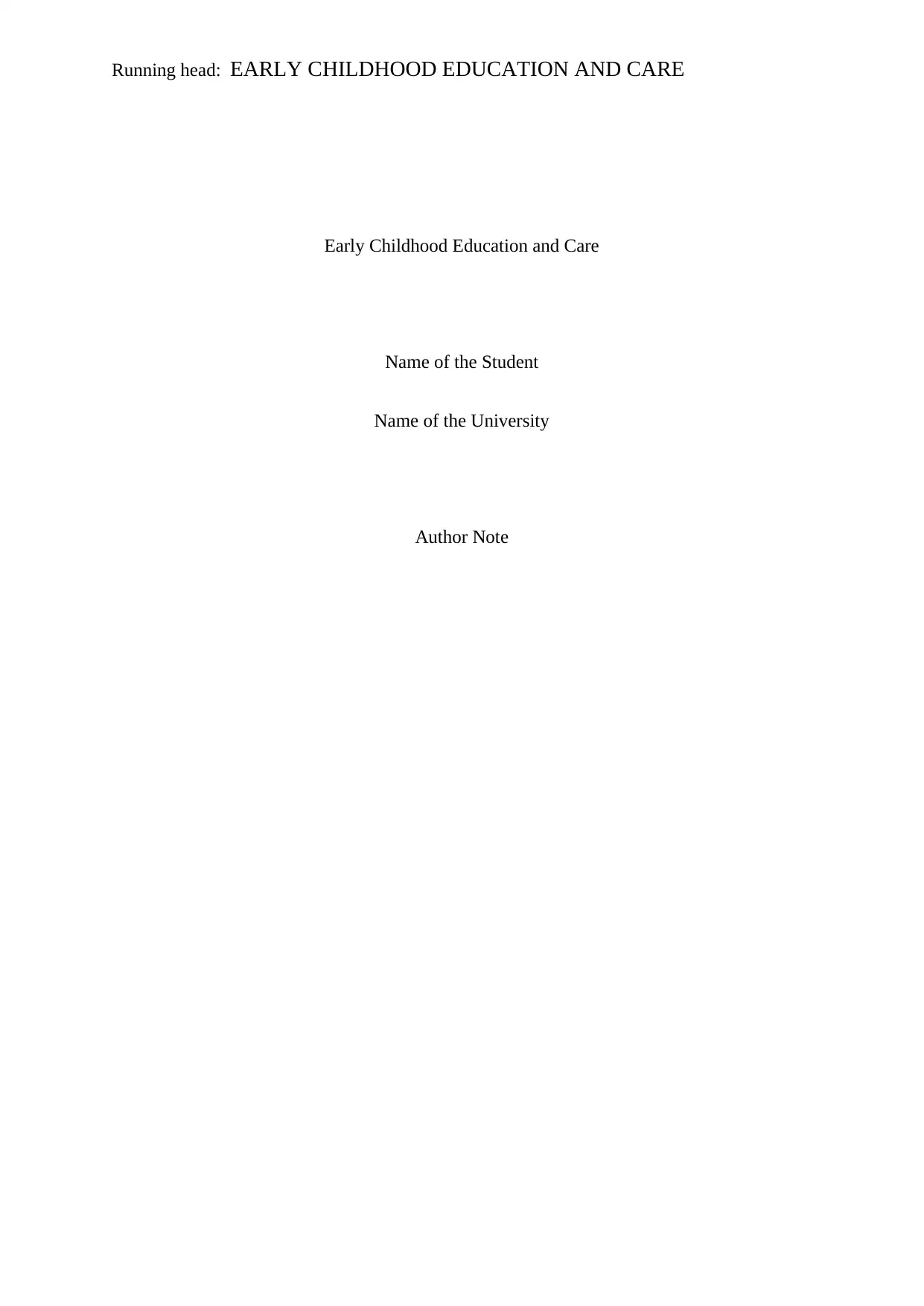
Running head: EARLY CHILDHOOD EDUCATION AND CARE
Early Childhood Education and Care
Name of the Student
Name of the University
Author Note
Early Childhood Education and Care
Name of the Student
Name of the University
Author Note
Secure Best Marks with AI Grader
Need help grading? Try our AI Grader for instant feedback on your assignments.
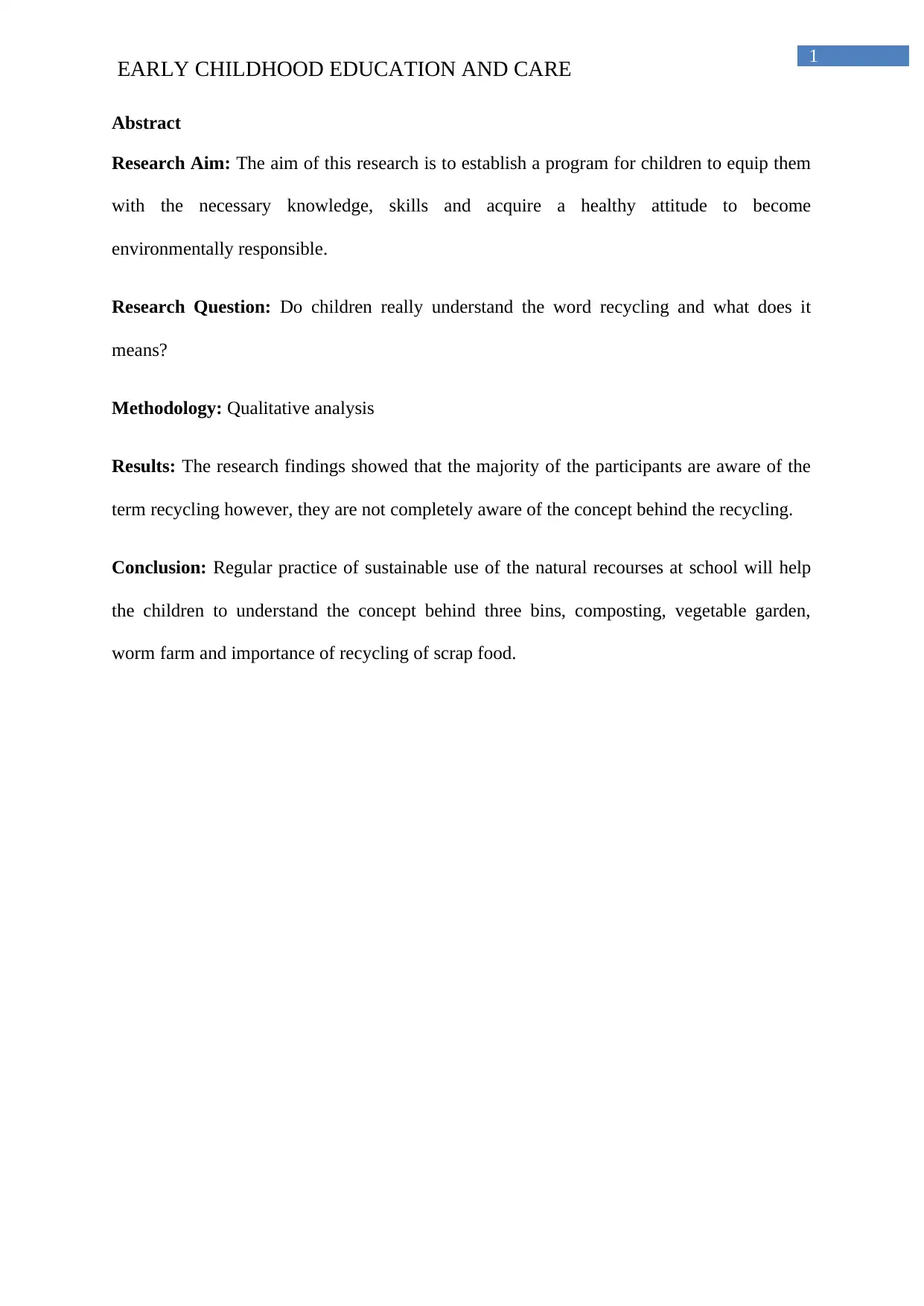
1
EARLY CHILDHOOD EDUCATION AND CARE
Abstract
Research Aim: The aim of this research is to establish a program for children to equip them
with the necessary knowledge, skills and acquire a healthy attitude to become
environmentally responsible.
Research Question: Do children really understand the word recycling and what does it
means?
Methodology: Qualitative analysis
Results: The research findings showed that the majority of the participants are aware of the
term recycling however, they are not completely aware of the concept behind the recycling.
Conclusion: Regular practice of sustainable use of the natural recourses at school will help
the children to understand the concept behind three bins, composting, vegetable garden,
worm farm and importance of recycling of scrap food.
EARLY CHILDHOOD EDUCATION AND CARE
Abstract
Research Aim: The aim of this research is to establish a program for children to equip them
with the necessary knowledge, skills and acquire a healthy attitude to become
environmentally responsible.
Research Question: Do children really understand the word recycling and what does it
means?
Methodology: Qualitative analysis
Results: The research findings showed that the majority of the participants are aware of the
term recycling however, they are not completely aware of the concept behind the recycling.
Conclusion: Regular practice of sustainable use of the natural recourses at school will help
the children to understand the concept behind three bins, composting, vegetable garden,
worm farm and importance of recycling of scrap food.
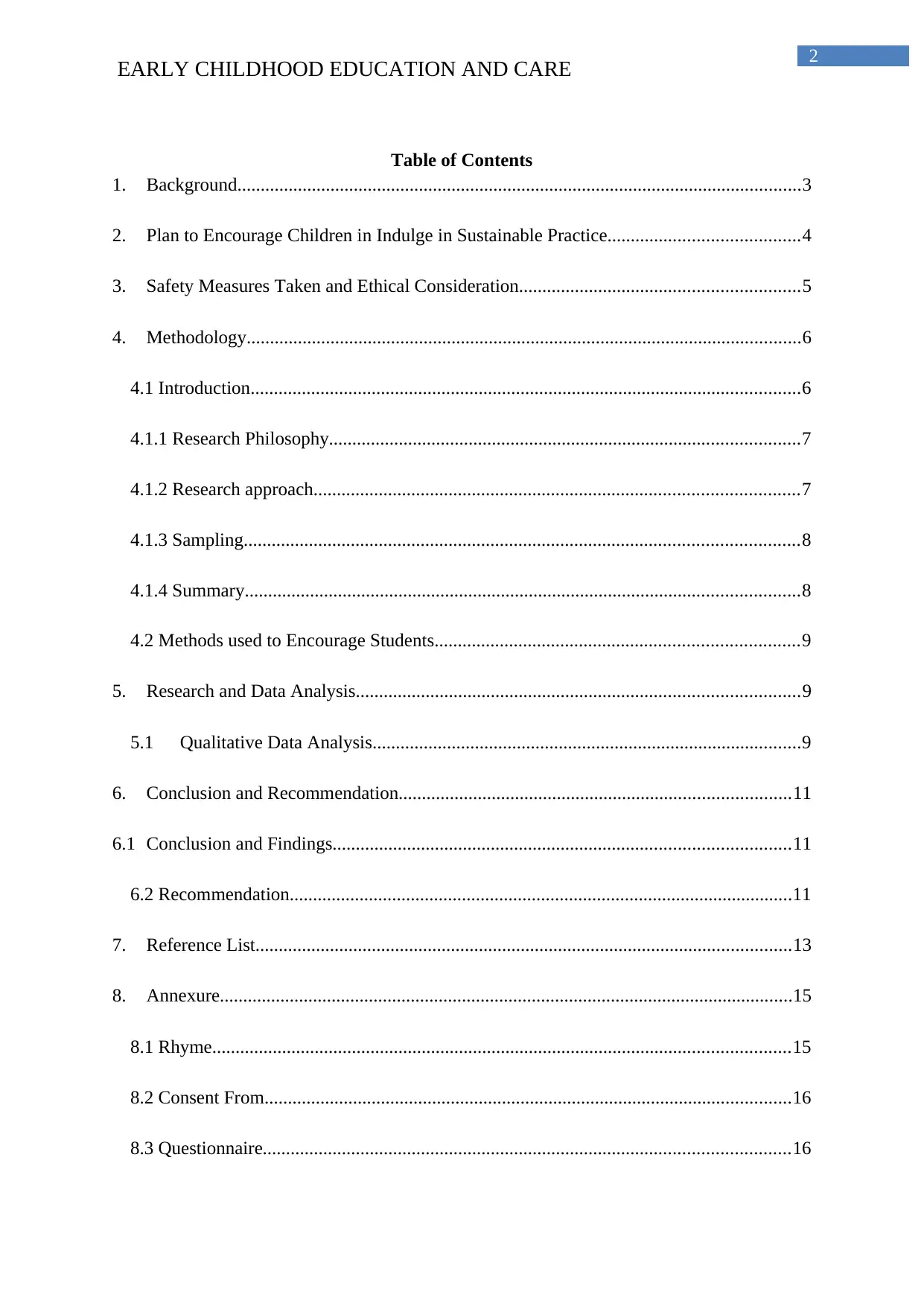
2
EARLY CHILDHOOD EDUCATION AND CARE
Table of Contents
1. Background.........................................................................................................................3
2. Plan to Encourage Children in Indulge in Sustainable Practice.........................................4
3. Safety Measures Taken and Ethical Consideration............................................................5
4. Methodology.......................................................................................................................6
4.1 Introduction......................................................................................................................6
4.1.1 Research Philosophy.....................................................................................................7
4.1.2 Research approach........................................................................................................7
4.1.3 Sampling.......................................................................................................................8
4.1.4 Summary.......................................................................................................................8
4.2 Methods used to Encourage Students..............................................................................9
5. Research and Data Analysis...............................................................................................9
5.1 Qualitative Data Analysis............................................................................................9
6. Conclusion and Recommendation....................................................................................11
6.1 Conclusion and Findings..................................................................................................11
6.2 Recommendation............................................................................................................11
7. Reference List...................................................................................................................13
8. Annexure...........................................................................................................................15
8.1 Rhyme............................................................................................................................15
8.2 Consent From.................................................................................................................16
8.3 Questionnaire.................................................................................................................16
EARLY CHILDHOOD EDUCATION AND CARE
Table of Contents
1. Background.........................................................................................................................3
2. Plan to Encourage Children in Indulge in Sustainable Practice.........................................4
3. Safety Measures Taken and Ethical Consideration............................................................5
4. Methodology.......................................................................................................................6
4.1 Introduction......................................................................................................................6
4.1.1 Research Philosophy.....................................................................................................7
4.1.2 Research approach........................................................................................................7
4.1.3 Sampling.......................................................................................................................8
4.1.4 Summary.......................................................................................................................8
4.2 Methods used to Encourage Students..............................................................................9
5. Research and Data Analysis...............................................................................................9
5.1 Qualitative Data Analysis............................................................................................9
6. Conclusion and Recommendation....................................................................................11
6.1 Conclusion and Findings..................................................................................................11
6.2 Recommendation............................................................................................................11
7. Reference List...................................................................................................................13
8. Annexure...........................................................................................................................15
8.1 Rhyme............................................................................................................................15
8.2 Consent From.................................................................................................................16
8.3 Questionnaire.................................................................................................................16
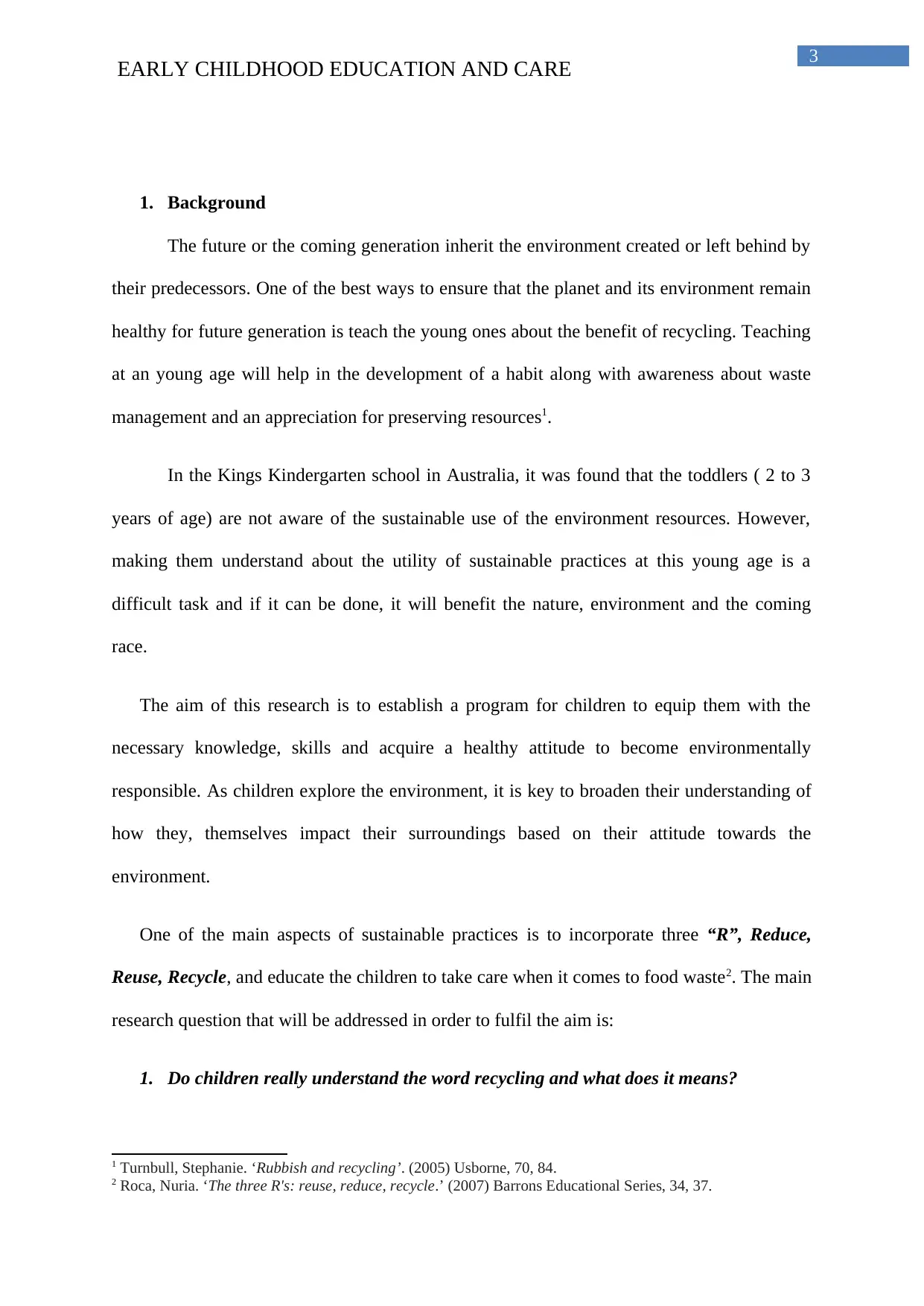
3
EARLY CHILDHOOD EDUCATION AND CARE
1. Background
The future or the coming generation inherit the environment created or left behind by
their predecessors. One of the best ways to ensure that the planet and its environment remain
healthy for future generation is teach the young ones about the benefit of recycling. Teaching
at an young age will help in the development of a habit along with awareness about waste
management and an appreciation for preserving resources1.
In the Kings Kindergarten school in Australia, it was found that the toddlers ( 2 to 3
years of age) are not aware of the sustainable use of the environment resources. However,
making them understand about the utility of sustainable practices at this young age is a
difficult task and if it can be done, it will benefit the nature, environment and the coming
race.
The aim of this research is to establish a program for children to equip them with the
necessary knowledge, skills and acquire a healthy attitude to become environmentally
responsible. As children explore the environment, it is key to broaden their understanding of
how they, themselves impact their surroundings based on their attitude towards the
environment.
One of the main aspects of sustainable practices is to incorporate three “R”, Reduce,
Reuse, Recycle, and educate the children to take care when it comes to food waste2. The main
research question that will be addressed in order to fulfil the aim is:
1. Do children really understand the word recycling and what does it means?
1 Turnbull, Stephanie. ‘Rubbish and recycling’. (2005) Usborne, 70, 84.
2 Roca, Nuria. ‘The three R's: reuse, reduce, recycle.’ (2007) Barrons Educational Series, 34, 37.
EARLY CHILDHOOD EDUCATION AND CARE
1. Background
The future or the coming generation inherit the environment created or left behind by
their predecessors. One of the best ways to ensure that the planet and its environment remain
healthy for future generation is teach the young ones about the benefit of recycling. Teaching
at an young age will help in the development of a habit along with awareness about waste
management and an appreciation for preserving resources1.
In the Kings Kindergarten school in Australia, it was found that the toddlers ( 2 to 3
years of age) are not aware of the sustainable use of the environment resources. However,
making them understand about the utility of sustainable practices at this young age is a
difficult task and if it can be done, it will benefit the nature, environment and the coming
race.
The aim of this research is to establish a program for children to equip them with the
necessary knowledge, skills and acquire a healthy attitude to become environmentally
responsible. As children explore the environment, it is key to broaden their understanding of
how they, themselves impact their surroundings based on their attitude towards the
environment.
One of the main aspects of sustainable practices is to incorporate three “R”, Reduce,
Reuse, Recycle, and educate the children to take care when it comes to food waste2. The main
research question that will be addressed in order to fulfil the aim is:
1. Do children really understand the word recycling and what does it means?
1 Turnbull, Stephanie. ‘Rubbish and recycling’. (2005) Usborne, 70, 84.
2 Roca, Nuria. ‘The three R's: reuse, reduce, recycle.’ (2007) Barrons Educational Series, 34, 37.
Secure Best Marks with AI Grader
Need help grading? Try our AI Grader for instant feedback on your assignments.
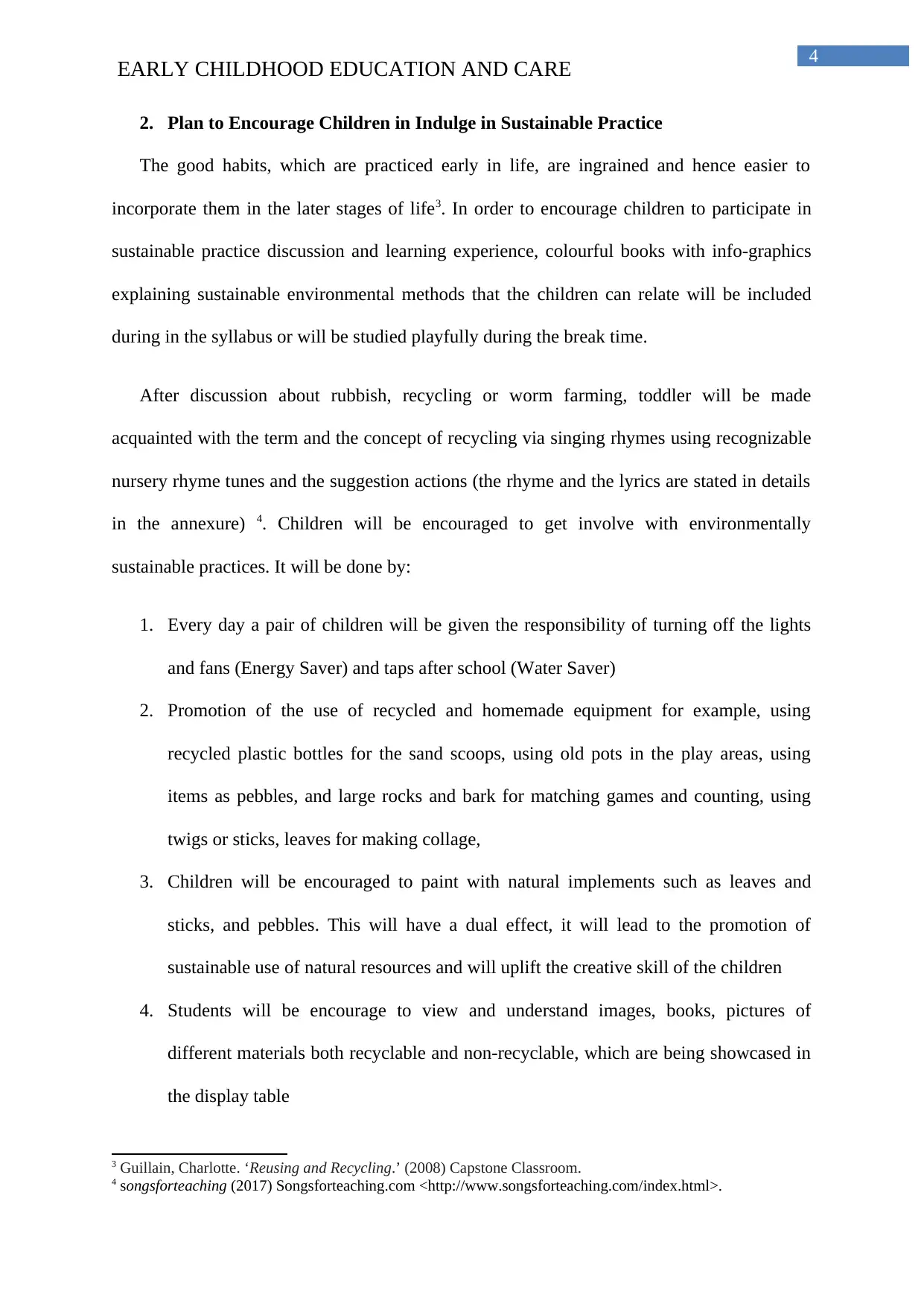
4
EARLY CHILDHOOD EDUCATION AND CARE
2. Plan to Encourage Children in Indulge in Sustainable Practice
The good habits, which are practiced early in life, are ingrained and hence easier to
incorporate them in the later stages of life3. In order to encourage children to participate in
sustainable practice discussion and learning experience, colourful books with info-graphics
explaining sustainable environmental methods that the children can relate will be included
during in the syllabus or will be studied playfully during the break time.
After discussion about rubbish, recycling or worm farming, toddler will be made
acquainted with the term and the concept of recycling via singing rhymes using recognizable
nursery rhyme tunes and the suggestion actions (the rhyme and the lyrics are stated in details
in the annexure) 4. Children will be encouraged to get involve with environmentally
sustainable practices. It will be done by:
1. Every day a pair of children will be given the responsibility of turning off the lights
and fans (Energy Saver) and taps after school (Water Saver)
2. Promotion of the use of recycled and homemade equipment for example, using
recycled plastic bottles for the sand scoops, using old pots in the play areas, using
items as pebbles, and large rocks and bark for matching games and counting, using
twigs or sticks, leaves for making collage,
3. Children will be encouraged to paint with natural implements such as leaves and
sticks, and pebbles. This will have a dual effect, it will lead to the promotion of
sustainable use of natural resources and will uplift the creative skill of the children
4. Students will be encourage to view and understand images, books, pictures of
different materials both recyclable and non-recyclable, which are being showcased in
the display table
3 Guillain, Charlotte. ‘Reusing and Recycling.’ (2008) Capstone Classroom.
4 songsforteaching (2017) Songsforteaching.com <http://www.songsforteaching.com/index.html>.
EARLY CHILDHOOD EDUCATION AND CARE
2. Plan to Encourage Children in Indulge in Sustainable Practice
The good habits, which are practiced early in life, are ingrained and hence easier to
incorporate them in the later stages of life3. In order to encourage children to participate in
sustainable practice discussion and learning experience, colourful books with info-graphics
explaining sustainable environmental methods that the children can relate will be included
during in the syllabus or will be studied playfully during the break time.
After discussion about rubbish, recycling or worm farming, toddler will be made
acquainted with the term and the concept of recycling via singing rhymes using recognizable
nursery rhyme tunes and the suggestion actions (the rhyme and the lyrics are stated in details
in the annexure) 4. Children will be encouraged to get involve with environmentally
sustainable practices. It will be done by:
1. Every day a pair of children will be given the responsibility of turning off the lights
and fans (Energy Saver) and taps after school (Water Saver)
2. Promotion of the use of recycled and homemade equipment for example, using
recycled plastic bottles for the sand scoops, using old pots in the play areas, using
items as pebbles, and large rocks and bark for matching games and counting, using
twigs or sticks, leaves for making collage,
3. Children will be encouraged to paint with natural implements such as leaves and
sticks, and pebbles. This will have a dual effect, it will lead to the promotion of
sustainable use of natural resources and will uplift the creative skill of the children
4. Students will be encourage to view and understand images, books, pictures of
different materials both recyclable and non-recyclable, which are being showcased in
the display table
3 Guillain, Charlotte. ‘Reusing and Recycling.’ (2008) Capstone Classroom.
4 songsforteaching (2017) Songsforteaching.com <http://www.songsforteaching.com/index.html>.
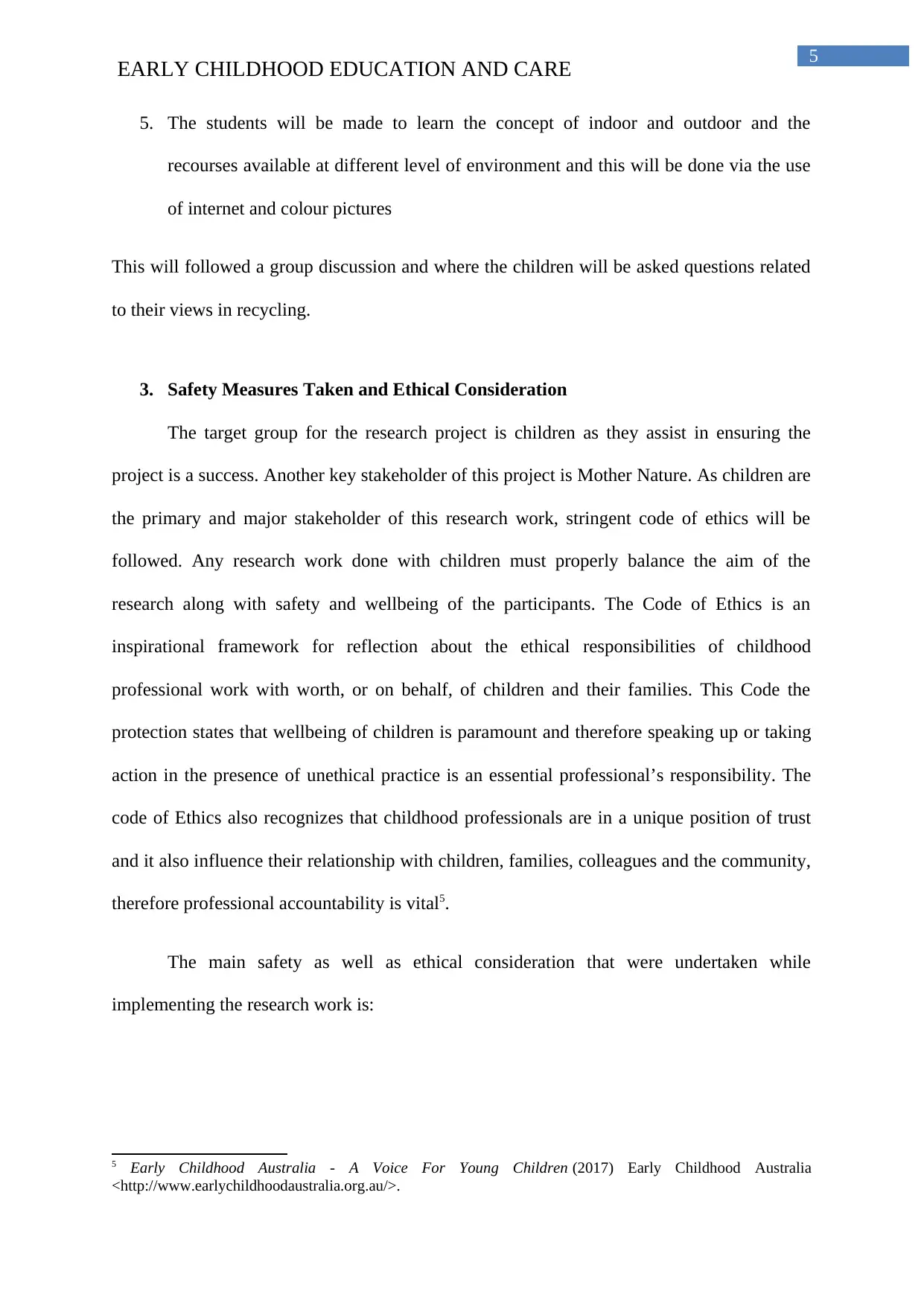
5
EARLY CHILDHOOD EDUCATION AND CARE
5. The students will be made to learn the concept of indoor and outdoor and the
recourses available at different level of environment and this will be done via the use
of internet and colour pictures
This will followed a group discussion and where the children will be asked questions related
to their views in recycling.
3. Safety Measures Taken and Ethical Consideration
The target group for the research project is children as they assist in ensuring the
project is a success. Another key stakeholder of this project is Mother Nature. As children are
the primary and major stakeholder of this research work, stringent code of ethics will be
followed. Any research work done with children must properly balance the aim of the
research along with safety and wellbeing of the participants. The Code of Ethics is an
inspirational framework for reflection about the ethical responsibilities of childhood
professional work with worth, or on behalf, of children and their families. This Code the
protection states that wellbeing of children is paramount and therefore speaking up or taking
action in the presence of unethical practice is an essential professional’s responsibility. The
code of Ethics also recognizes that childhood professionals are in a unique position of trust
and it also influence their relationship with children, families, colleagues and the community,
therefore professional accountability is vital5.
The main safety as well as ethical consideration that were undertaken while
implementing the research work is:
5 Early Childhood Australia - A Voice For Young Children (2017) Early Childhood Australia
<http://www.earlychildhoodaustralia.org.au/>.
EARLY CHILDHOOD EDUCATION AND CARE
5. The students will be made to learn the concept of indoor and outdoor and the
recourses available at different level of environment and this will be done via the use
of internet and colour pictures
This will followed a group discussion and where the children will be asked questions related
to their views in recycling.
3. Safety Measures Taken and Ethical Consideration
The target group for the research project is children as they assist in ensuring the
project is a success. Another key stakeholder of this project is Mother Nature. As children are
the primary and major stakeholder of this research work, stringent code of ethics will be
followed. Any research work done with children must properly balance the aim of the
research along with safety and wellbeing of the participants. The Code of Ethics is an
inspirational framework for reflection about the ethical responsibilities of childhood
professional work with worth, or on behalf, of children and their families. This Code the
protection states that wellbeing of children is paramount and therefore speaking up or taking
action in the presence of unethical practice is an essential professional’s responsibility. The
code of Ethics also recognizes that childhood professionals are in a unique position of trust
and it also influence their relationship with children, families, colleagues and the community,
therefore professional accountability is vital5.
The main safety as well as ethical consideration that were undertaken while
implementing the research work is:
5 Early Childhood Australia - A Voice For Young Children (2017) Early Childhood Australia
<http://www.earlychildhoodaustralia.org.au/>.
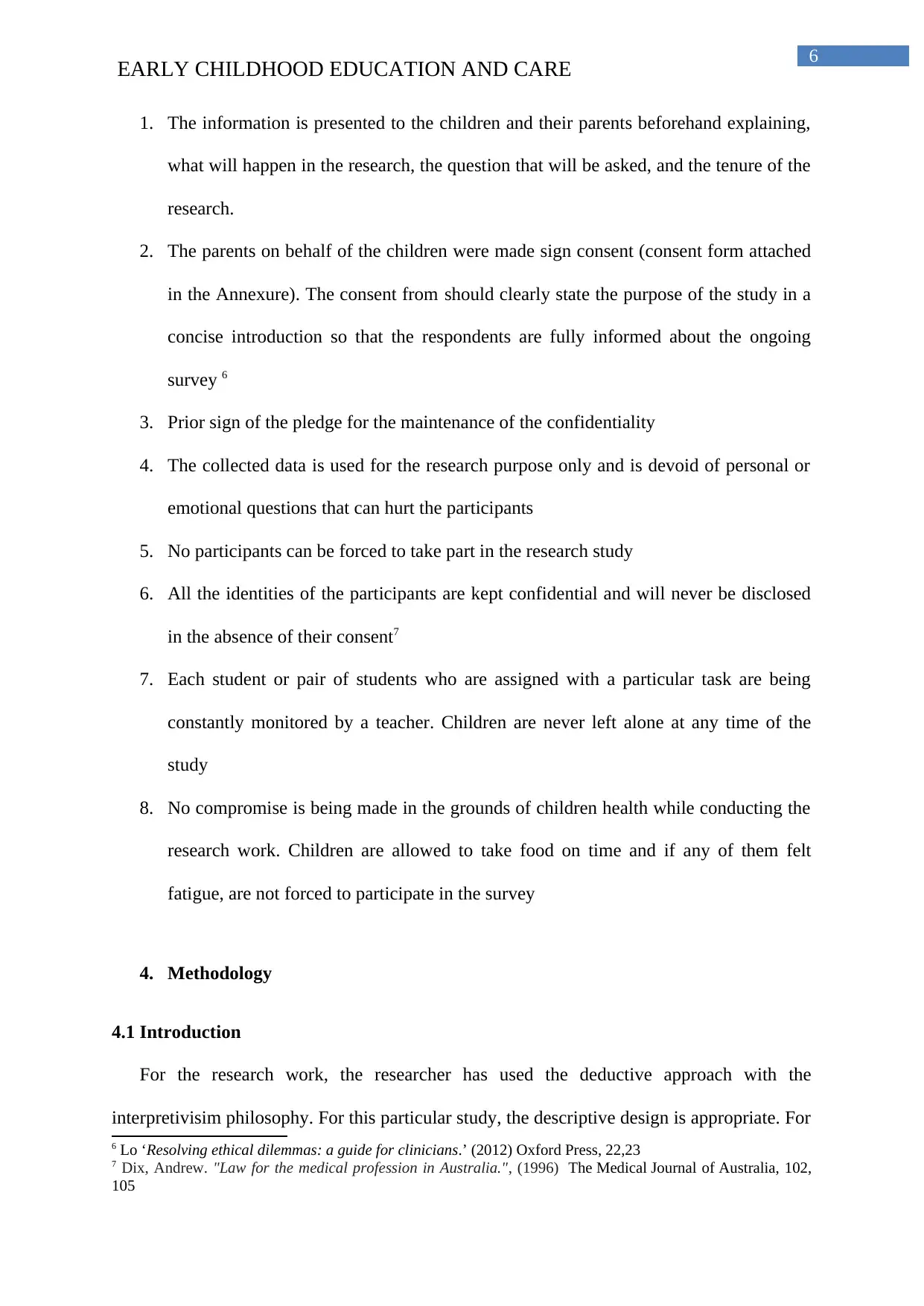
6
EARLY CHILDHOOD EDUCATION AND CARE
1. The information is presented to the children and their parents beforehand explaining,
what will happen in the research, the question that will be asked, and the tenure of the
research.
2. The parents on behalf of the children were made sign consent (consent form attached
in the Annexure). The consent from should clearly state the purpose of the study in a
concise introduction so that the respondents are fully informed about the ongoing
survey 6
3. Prior sign of the pledge for the maintenance of the confidentiality
4. The collected data is used for the research purpose only and is devoid of personal or
emotional questions that can hurt the participants
5. No participants can be forced to take part in the research study
6. All the identities of the participants are kept confidential and will never be disclosed
in the absence of their consent7
7. Each student or pair of students who are assigned with a particular task are being
constantly monitored by a teacher. Children are never left alone at any time of the
study
8. No compromise is being made in the grounds of children health while conducting the
research work. Children are allowed to take food on time and if any of them felt
fatigue, are not forced to participate in the survey
4. Methodology
4.1 Introduction
For the research work, the researcher has used the deductive approach with the
interpretivisim philosophy. For this particular study, the descriptive design is appropriate. For
6 Lo ‘Resolving ethical dilemmas: a guide for clinicians.’ (2012) Oxford Press, 22,23
7 Dix, Andrew. "Law for the medical profession in Australia.", (1996) The Medical Journal of Australia, 102,
105
EARLY CHILDHOOD EDUCATION AND CARE
1. The information is presented to the children and their parents beforehand explaining,
what will happen in the research, the question that will be asked, and the tenure of the
research.
2. The parents on behalf of the children were made sign consent (consent form attached
in the Annexure). The consent from should clearly state the purpose of the study in a
concise introduction so that the respondents are fully informed about the ongoing
survey 6
3. Prior sign of the pledge for the maintenance of the confidentiality
4. The collected data is used for the research purpose only and is devoid of personal or
emotional questions that can hurt the participants
5. No participants can be forced to take part in the research study
6. All the identities of the participants are kept confidential and will never be disclosed
in the absence of their consent7
7. Each student or pair of students who are assigned with a particular task are being
constantly monitored by a teacher. Children are never left alone at any time of the
study
8. No compromise is being made in the grounds of children health while conducting the
research work. Children are allowed to take food on time and if any of them felt
fatigue, are not forced to participate in the survey
4. Methodology
4.1 Introduction
For the research work, the researcher has used the deductive approach with the
interpretivisim philosophy. For this particular study, the descriptive design is appropriate. For
6 Lo ‘Resolving ethical dilemmas: a guide for clinicians.’ (2012) Oxford Press, 22,23
7 Dix, Andrew. "Law for the medical profession in Australia.", (1996) The Medical Journal of Australia, 102,
105
Paraphrase This Document
Need a fresh take? Get an instant paraphrase of this document with our AI Paraphraser
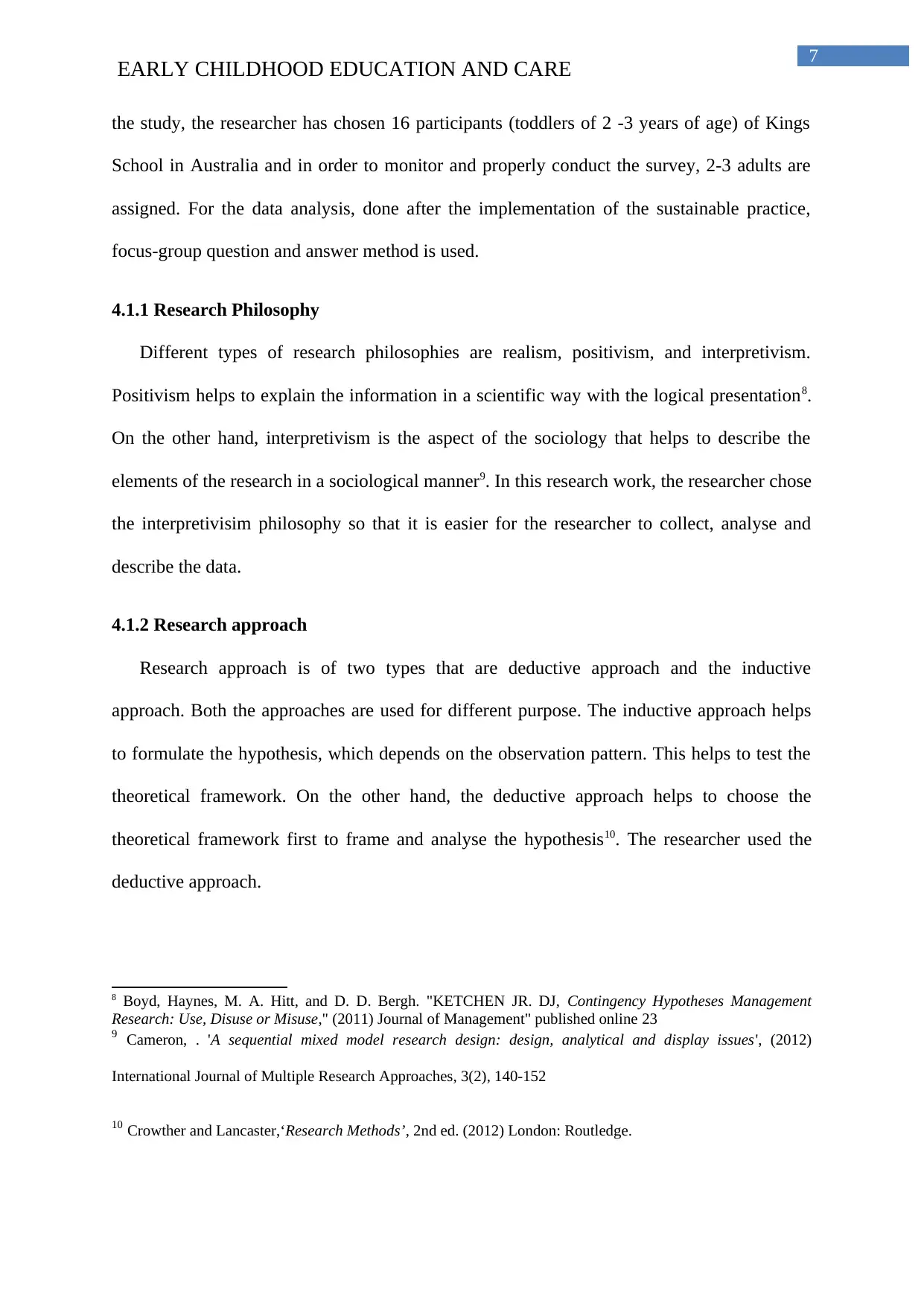
7
EARLY CHILDHOOD EDUCATION AND CARE
the study, the researcher has chosen 16 participants (toddlers of 2 -3 years of age) of Kings
School in Australia and in order to monitor and properly conduct the survey, 2-3 adults are
assigned. For the data analysis, done after the implementation of the sustainable practice,
focus-group question and answer method is used.
4.1.1 Research Philosophy
Different types of research philosophies are realism, positivism, and interpretivism.
Positivism helps to explain the information in a scientific way with the logical presentation8.
On the other hand, interpretivism is the aspect of the sociology that helps to describe the
elements of the research in a sociological manner9. In this research work, the researcher chose
the interpretivisim philosophy so that it is easier for the researcher to collect, analyse and
describe the data.
4.1.2 Research approach
Research approach is of two types that are deductive approach and the inductive
approach. Both the approaches are used for different purpose. The inductive approach helps
to formulate the hypothesis, which depends on the observation pattern. This helps to test the
theoretical framework. On the other hand, the deductive approach helps to choose the
theoretical framework first to frame and analyse the hypothesis10. The researcher used the
deductive approach.
8 Boyd, Haynes, M. A. Hitt, and D. D. Bergh. "KETCHEN JR. DJ, Contingency Hypotheses Management
Research: Use, Disuse or Misuse," (2011) Journal of Management" published online 23
9 Cameron, . 'A sequential mixed model research design: design, analytical and display issues', (2012)
International Journal of Multiple Research Approaches, 3(2), 140-152
10 Crowther and Lancaster,‘Research Methods’, 2nd ed. (2012) London: Routledge.
EARLY CHILDHOOD EDUCATION AND CARE
the study, the researcher has chosen 16 participants (toddlers of 2 -3 years of age) of Kings
School in Australia and in order to monitor and properly conduct the survey, 2-3 adults are
assigned. For the data analysis, done after the implementation of the sustainable practice,
focus-group question and answer method is used.
4.1.1 Research Philosophy
Different types of research philosophies are realism, positivism, and interpretivism.
Positivism helps to explain the information in a scientific way with the logical presentation8.
On the other hand, interpretivism is the aspect of the sociology that helps to describe the
elements of the research in a sociological manner9. In this research work, the researcher chose
the interpretivisim philosophy so that it is easier for the researcher to collect, analyse and
describe the data.
4.1.2 Research approach
Research approach is of two types that are deductive approach and the inductive
approach. Both the approaches are used for different purpose. The inductive approach helps
to formulate the hypothesis, which depends on the observation pattern. This helps to test the
theoretical framework. On the other hand, the deductive approach helps to choose the
theoretical framework first to frame and analyse the hypothesis10. The researcher used the
deductive approach.
8 Boyd, Haynes, M. A. Hitt, and D. D. Bergh. "KETCHEN JR. DJ, Contingency Hypotheses Management
Research: Use, Disuse or Misuse," (2011) Journal of Management" published online 23
9 Cameron, . 'A sequential mixed model research design: design, analytical and display issues', (2012)
International Journal of Multiple Research Approaches, 3(2), 140-152
10 Crowther and Lancaster,‘Research Methods’, 2nd ed. (2012) London: Routledge.
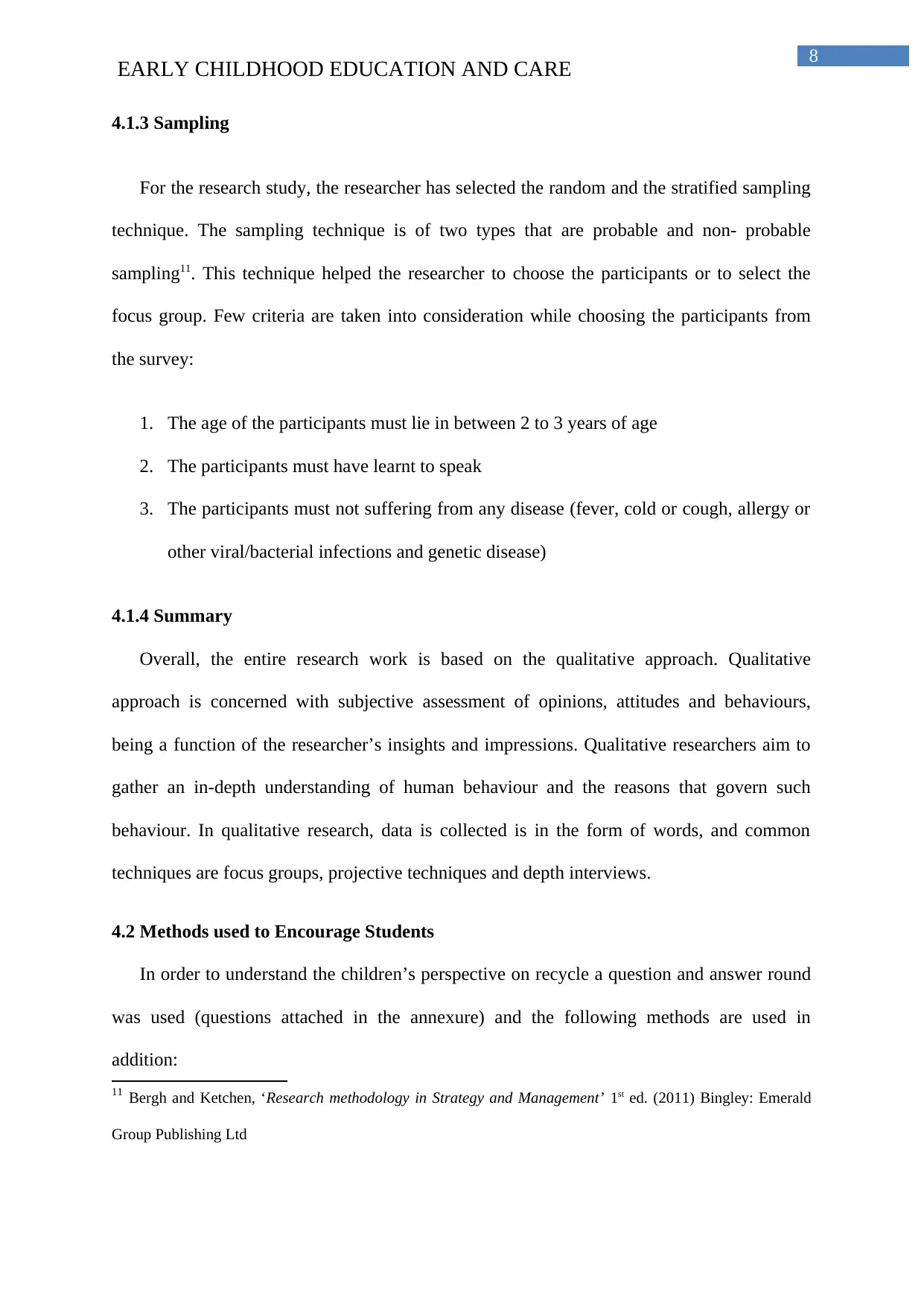
8
EARLY CHILDHOOD EDUCATION AND CARE
4.1.3 Sampling
For the research study, the researcher has selected the random and the stratified sampling
technique. The sampling technique is of two types that are probable and non- probable
sampling11. This technique helped the researcher to choose the participants or to select the
focus group. Few criteria are taken into consideration while choosing the participants from
the survey:
1. The age of the participants must lie in between 2 to 3 years of age
2. The participants must have learnt to speak
3. The participants must not suffering from any disease (fever, cold or cough, allergy or
other viral/bacterial infections and genetic disease)
4.1.4 Summary
Overall, the entire research work is based on the qualitative approach. Qualitative
approach is concerned with subjective assessment of opinions, attitudes and behaviours,
being a function of the researcher’s insights and impressions. Qualitative researchers aim to
gather an in-depth understanding of human behaviour and the reasons that govern such
behaviour. In qualitative research, data is collected is in the form of words, and common
techniques are focus groups, projective techniques and depth interviews.
4.2 Methods used to Encourage Students
In order to understand the children’s perspective on recycle a question and answer round
was used (questions attached in the annexure) and the following methods are used in
addition:
11 Bergh and Ketchen, ‘Research methodology in Strategy and Management’ 1st ed. (2011) Bingley: Emerald
Group Publishing Ltd
EARLY CHILDHOOD EDUCATION AND CARE
4.1.3 Sampling
For the research study, the researcher has selected the random and the stratified sampling
technique. The sampling technique is of two types that are probable and non- probable
sampling11. This technique helped the researcher to choose the participants or to select the
focus group. Few criteria are taken into consideration while choosing the participants from
the survey:
1. The age of the participants must lie in between 2 to 3 years of age
2. The participants must have learnt to speak
3. The participants must not suffering from any disease (fever, cold or cough, allergy or
other viral/bacterial infections and genetic disease)
4.1.4 Summary
Overall, the entire research work is based on the qualitative approach. Qualitative
approach is concerned with subjective assessment of opinions, attitudes and behaviours,
being a function of the researcher’s insights and impressions. Qualitative researchers aim to
gather an in-depth understanding of human behaviour and the reasons that govern such
behaviour. In qualitative research, data is collected is in the form of words, and common
techniques are focus groups, projective techniques and depth interviews.
4.2 Methods used to Encourage Students
In order to understand the children’s perspective on recycle a question and answer round
was used (questions attached in the annexure) and the following methods are used in
addition:
11 Bergh and Ketchen, ‘Research methodology in Strategy and Management’ 1st ed. (2011) Bingley: Emerald
Group Publishing Ltd
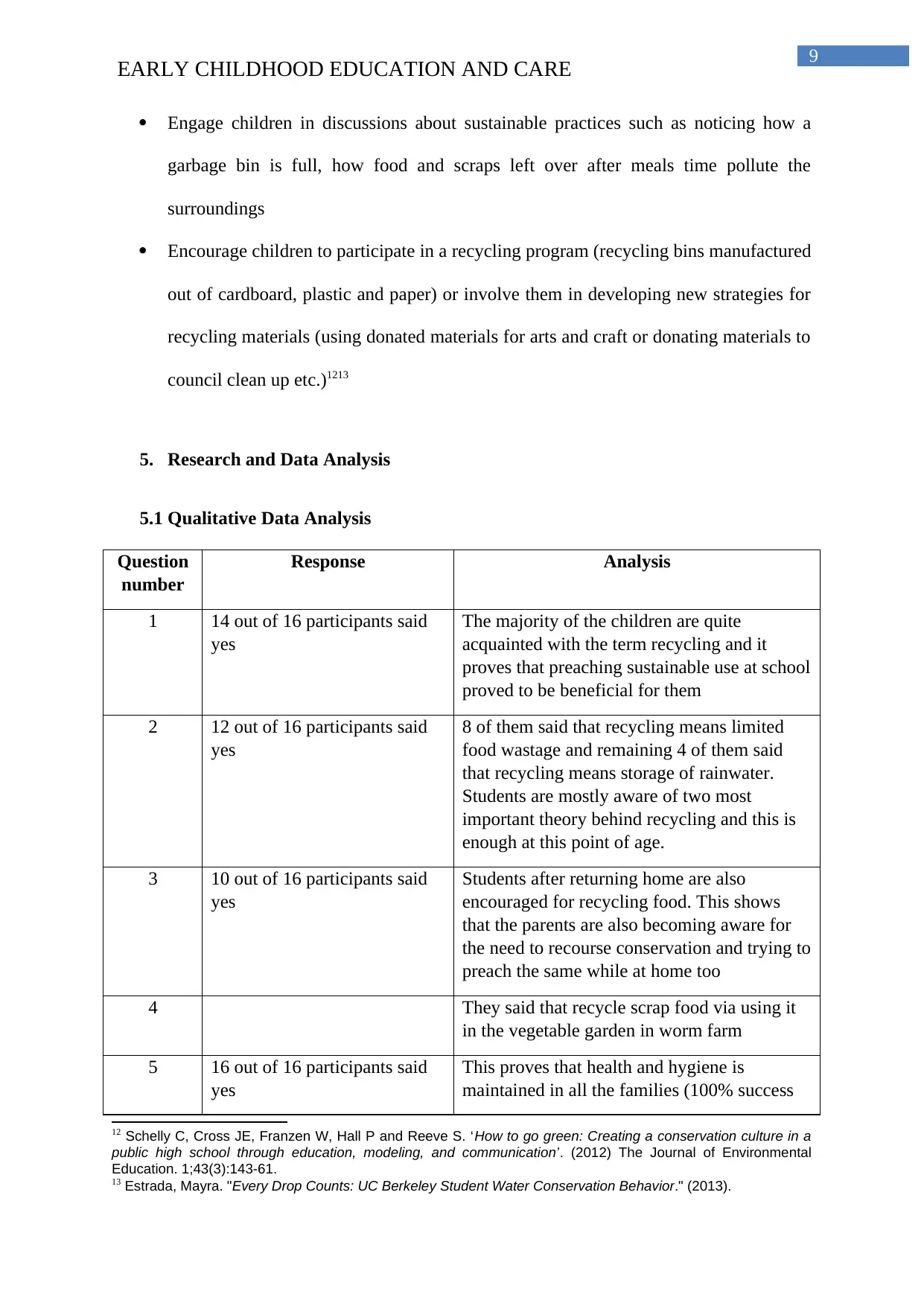
9
EARLY CHILDHOOD EDUCATION AND CARE
Engage children in discussions about sustainable practices such as noticing how a
garbage bin is full, how food and scraps left over after meals time pollute the
surroundings
Encourage children to participate in a recycling program (recycling bins manufactured
out of cardboard, plastic and paper) or involve them in developing new strategies for
recycling materials (using donated materials for arts and craft or donating materials to
council clean up etc.)1213
5. Research and Data Analysis
5.1 Qualitative Data Analysis
Question
number
Response Analysis
1 14 out of 16 participants said
yes
The majority of the children are quite
acquainted with the term recycling and it
proves that preaching sustainable use at school
proved to be beneficial for them
2 12 out of 16 participants said
yes
8 of them said that recycling means limited
food wastage and remaining 4 of them said
that recycling means storage of rainwater.
Students are mostly aware of two most
important theory behind recycling and this is
enough at this point of age.
3 10 out of 16 participants said
yes
Students after returning home are also
encouraged for recycling food. This shows
that the parents are also becoming aware for
the need to recourse conservation and trying to
preach the same while at home too
4 They said that recycle scrap food via using it
in the vegetable garden in worm farm
5 16 out of 16 participants said
yes
This proves that health and hygiene is
maintained in all the families (100% success
12 Schelly C, Cross JE, Franzen W, Hall P and Reeve S. ‘How to go green: Creating a conservation culture in a
public high school through education, modeling, and communication’. (2012) The Journal of Environmental
Education. 1;43(3):143-61.
13 Estrada, Mayra. "Every Drop Counts: UC Berkeley Student Water Conservation Behavior." (2013).
EARLY CHILDHOOD EDUCATION AND CARE
Engage children in discussions about sustainable practices such as noticing how a
garbage bin is full, how food and scraps left over after meals time pollute the
surroundings
Encourage children to participate in a recycling program (recycling bins manufactured
out of cardboard, plastic and paper) or involve them in developing new strategies for
recycling materials (using donated materials for arts and craft or donating materials to
council clean up etc.)1213
5. Research and Data Analysis
5.1 Qualitative Data Analysis
Question
number
Response Analysis
1 14 out of 16 participants said
yes
The majority of the children are quite
acquainted with the term recycling and it
proves that preaching sustainable use at school
proved to be beneficial for them
2 12 out of 16 participants said
yes
8 of them said that recycling means limited
food wastage and remaining 4 of them said
that recycling means storage of rainwater.
Students are mostly aware of two most
important theory behind recycling and this is
enough at this point of age.
3 10 out of 16 participants said
yes
Students after returning home are also
encouraged for recycling food. This shows
that the parents are also becoming aware for
the need to recourse conservation and trying to
preach the same while at home too
4 They said that recycle scrap food via using it
in the vegetable garden in worm farm
5 16 out of 16 participants said
yes
This proves that health and hygiene is
maintained in all the families (100% success
12 Schelly C, Cross JE, Franzen W, Hall P and Reeve S. ‘How to go green: Creating a conservation culture in a
public high school through education, modeling, and communication’. (2012) The Journal of Environmental
Education. 1;43(3):143-61.
13 Estrada, Mayra. "Every Drop Counts: UC Berkeley Student Water Conservation Behavior." (2013).
Secure Best Marks with AI Grader
Need help grading? Try our AI Grader for instant feedback on your assignments.
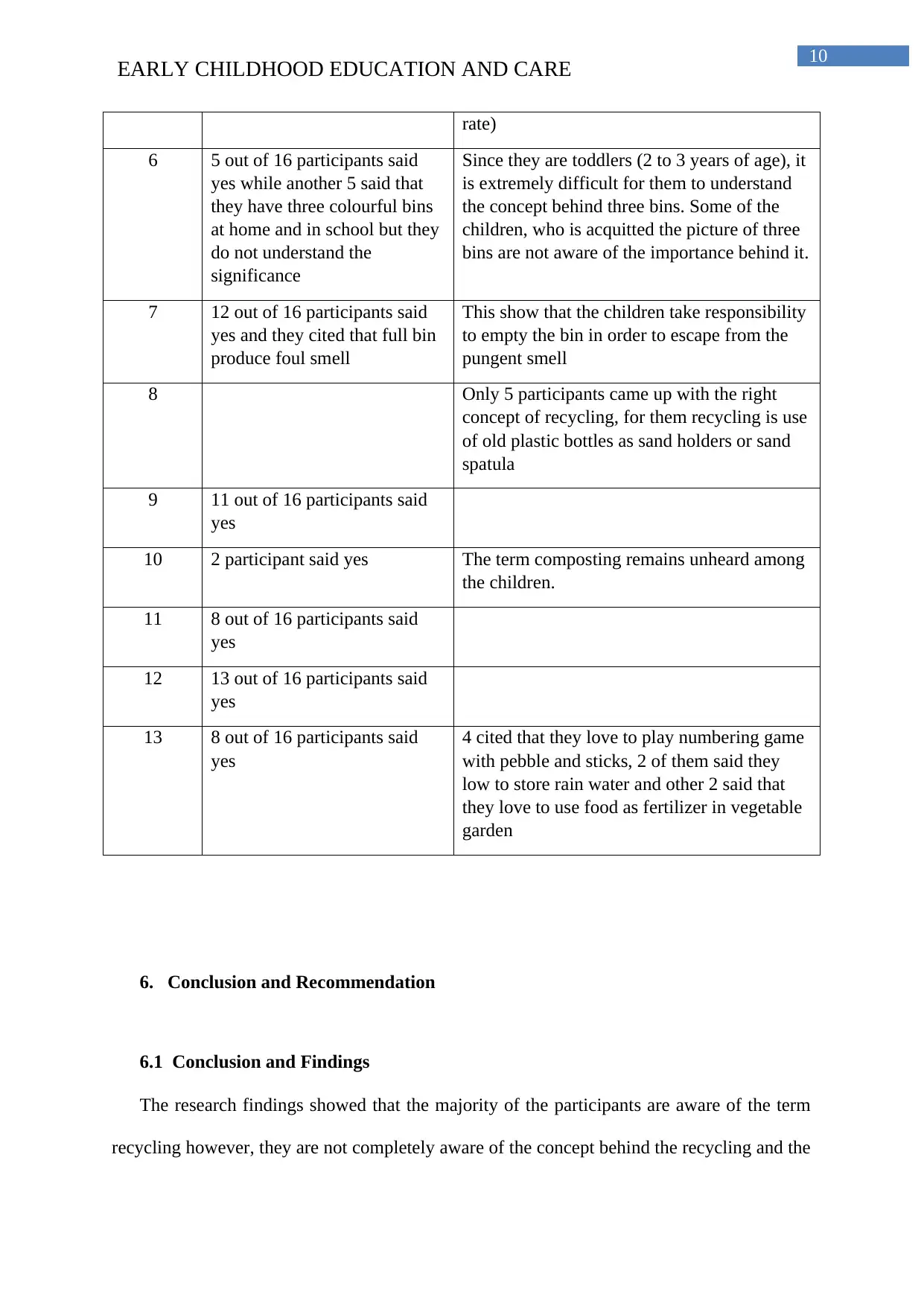
10
EARLY CHILDHOOD EDUCATION AND CARE
rate)
6 5 out of 16 participants said
yes while another 5 said that
they have three colourful bins
at home and in school but they
do not understand the
significance
Since they are toddlers (2 to 3 years of age), it
is extremely difficult for them to understand
the concept behind three bins. Some of the
children, who is acquitted the picture of three
bins are not aware of the importance behind it.
7 12 out of 16 participants said
yes and they cited that full bin
produce foul smell
This show that the children take responsibility
to empty the bin in order to escape from the
pungent smell
8 Only 5 participants came up with the right
concept of recycling, for them recycling is use
of old plastic bottles as sand holders or sand
spatula
9 11 out of 16 participants said
yes
10 2 participant said yes The term composting remains unheard among
the children.
11 8 out of 16 participants said
yes
12 13 out of 16 participants said
yes
13 8 out of 16 participants said
yes
4 cited that they love to play numbering game
with pebble and sticks, 2 of them said they
low to store rain water and other 2 said that
they love to use food as fertilizer in vegetable
garden
6. Conclusion and Recommendation
6.1 Conclusion and Findings
The research findings showed that the majority of the participants are aware of the term
recycling however, they are not completely aware of the concept behind the recycling and the
EARLY CHILDHOOD EDUCATION AND CARE
rate)
6 5 out of 16 participants said
yes while another 5 said that
they have three colourful bins
at home and in school but they
do not understand the
significance
Since they are toddlers (2 to 3 years of age), it
is extremely difficult for them to understand
the concept behind three bins. Some of the
children, who is acquitted the picture of three
bins are not aware of the importance behind it.
7 12 out of 16 participants said
yes and they cited that full bin
produce foul smell
This show that the children take responsibility
to empty the bin in order to escape from the
pungent smell
8 Only 5 participants came up with the right
concept of recycling, for them recycling is use
of old plastic bottles as sand holders or sand
spatula
9 11 out of 16 participants said
yes
10 2 participant said yes The term composting remains unheard among
the children.
11 8 out of 16 participants said
yes
12 13 out of 16 participants said
yes
13 8 out of 16 participants said
yes
4 cited that they love to play numbering game
with pebble and sticks, 2 of them said they
low to store rain water and other 2 said that
they love to use food as fertilizer in vegetable
garden
6. Conclusion and Recommendation
6.1 Conclusion and Findings
The research findings showed that the majority of the participants are aware of the term
recycling however, they are not completely aware of the concept behind the recycling and the
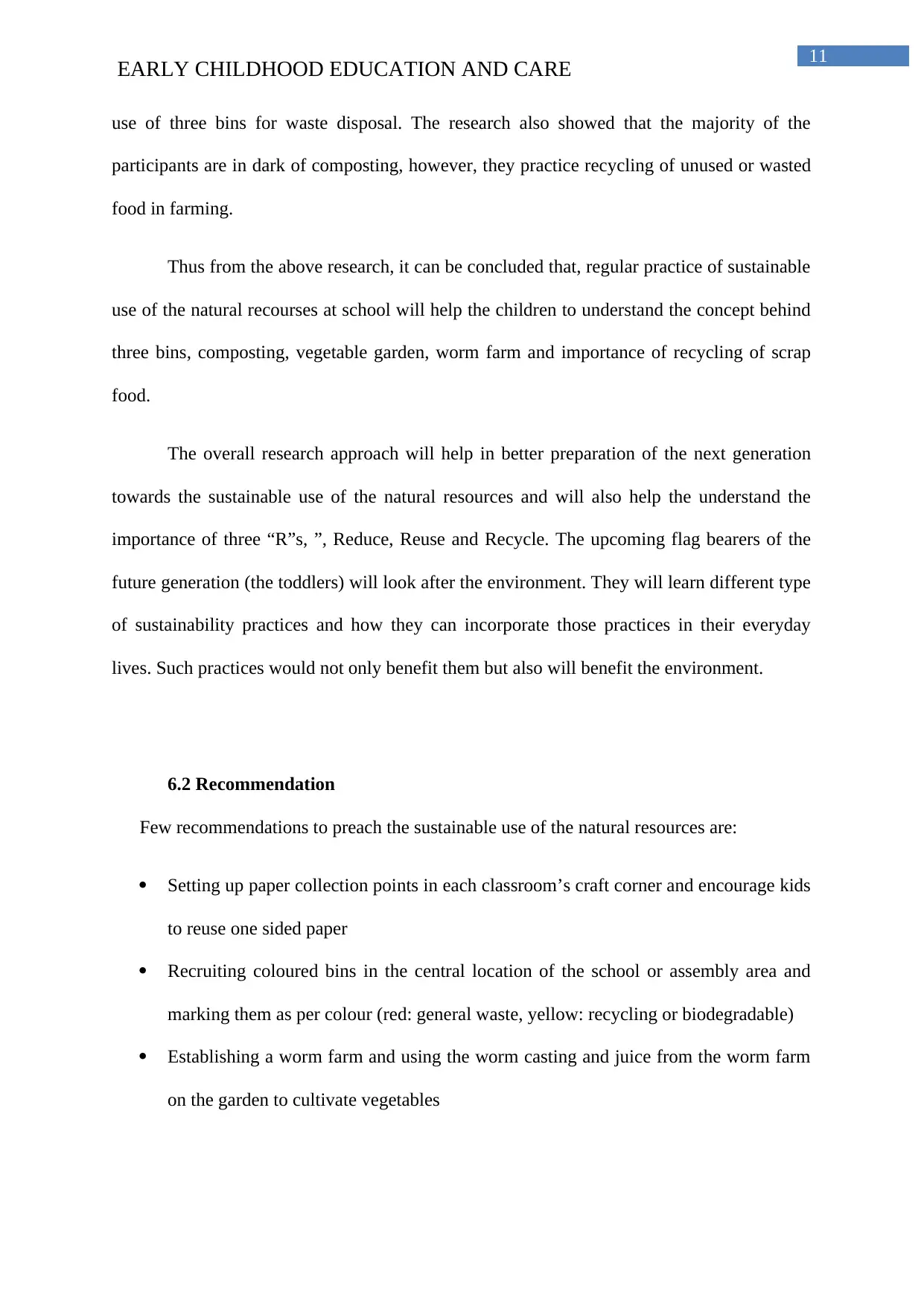
11
EARLY CHILDHOOD EDUCATION AND CARE
use of three bins for waste disposal. The research also showed that the majority of the
participants are in dark of composting, however, they practice recycling of unused or wasted
food in farming.
Thus from the above research, it can be concluded that, regular practice of sustainable
use of the natural recourses at school will help the children to understand the concept behind
three bins, composting, vegetable garden, worm farm and importance of recycling of scrap
food.
The overall research approach will help in better preparation of the next generation
towards the sustainable use of the natural resources and will also help the understand the
importance of three “R”s, ”, Reduce, Reuse and Recycle. The upcoming flag bearers of the
future generation (the toddlers) will look after the environment. They will learn different type
of sustainability practices and how they can incorporate those practices in their everyday
lives. Such practices would not only benefit them but also will benefit the environment.
6.2 Recommendation
Few recommendations to preach the sustainable use of the natural resources are:
Setting up paper collection points in each classroom’s craft corner and encourage kids
to reuse one sided paper
Recruiting coloured bins in the central location of the school or assembly area and
marking them as per colour (red: general waste, yellow: recycling or biodegradable)
Establishing a worm farm and using the worm casting and juice from the worm farm
on the garden to cultivate vegetables
EARLY CHILDHOOD EDUCATION AND CARE
use of three bins for waste disposal. The research also showed that the majority of the
participants are in dark of composting, however, they practice recycling of unused or wasted
food in farming.
Thus from the above research, it can be concluded that, regular practice of sustainable
use of the natural recourses at school will help the children to understand the concept behind
three bins, composting, vegetable garden, worm farm and importance of recycling of scrap
food.
The overall research approach will help in better preparation of the next generation
towards the sustainable use of the natural resources and will also help the understand the
importance of three “R”s, ”, Reduce, Reuse and Recycle. The upcoming flag bearers of the
future generation (the toddlers) will look after the environment. They will learn different type
of sustainability practices and how they can incorporate those practices in their everyday
lives. Such practices would not only benefit them but also will benefit the environment.
6.2 Recommendation
Few recommendations to preach the sustainable use of the natural resources are:
Setting up paper collection points in each classroom’s craft corner and encourage kids
to reuse one sided paper
Recruiting coloured bins in the central location of the school or assembly area and
marking them as per colour (red: general waste, yellow: recycling or biodegradable)
Establishing a worm farm and using the worm casting and juice from the worm farm
on the garden to cultivate vegetables
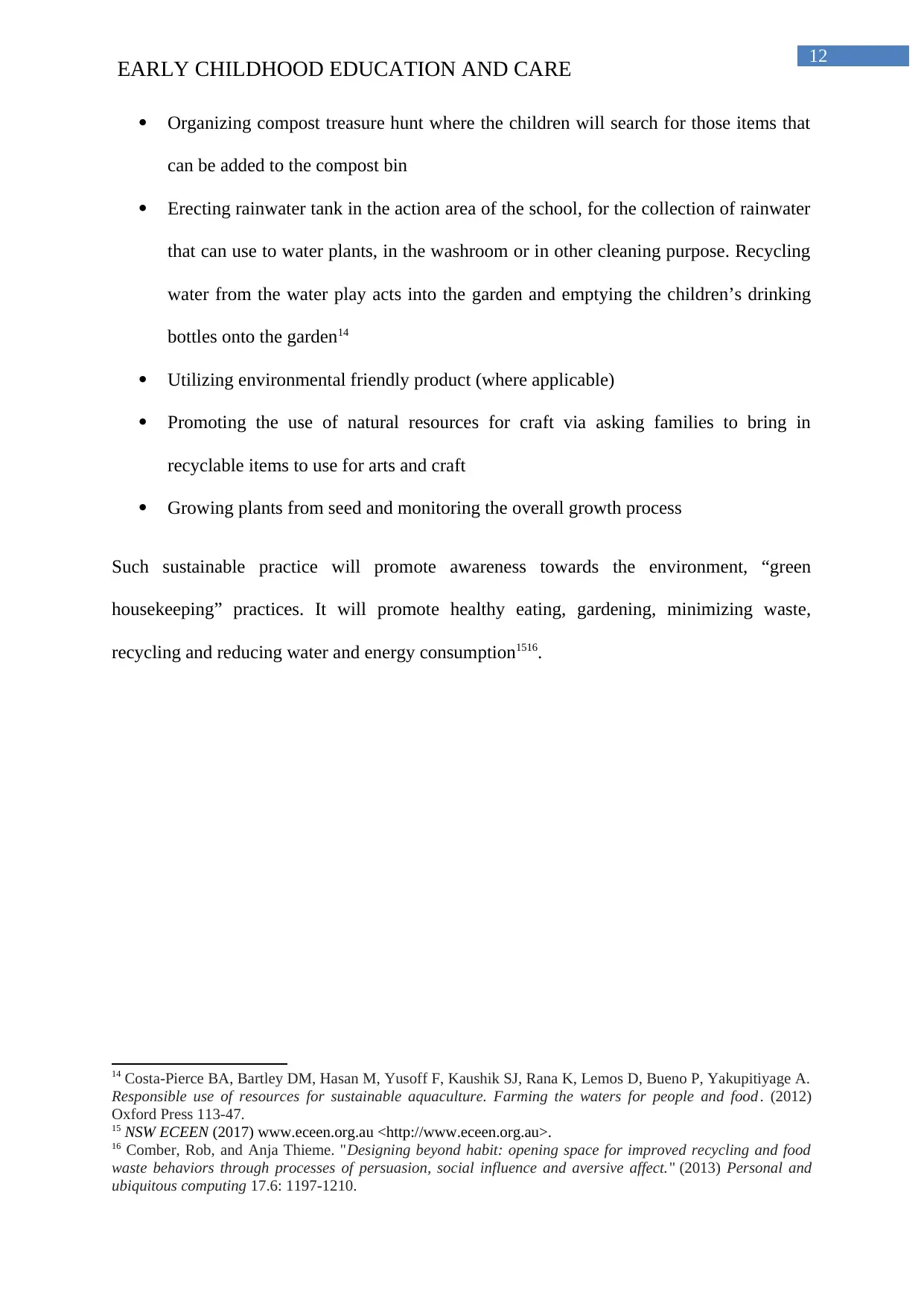
12
EARLY CHILDHOOD EDUCATION AND CARE
Organizing compost treasure hunt where the children will search for those items that
can be added to the compost bin
Erecting rainwater tank in the action area of the school, for the collection of rainwater
that can use to water plants, in the washroom or in other cleaning purpose. Recycling
water from the water play acts into the garden and emptying the children’s drinking
bottles onto the garden14
Utilizing environmental friendly product (where applicable)
Promoting the use of natural resources for craft via asking families to bring in
recyclable items to use for arts and craft
Growing plants from seed and monitoring the overall growth process
Such sustainable practice will promote awareness towards the environment, “green
housekeeping” practices. It will promote healthy eating, gardening, minimizing waste,
recycling and reducing water and energy consumption1516.
14 Costa-Pierce BA, Bartley DM, Hasan M, Yusoff F, Kaushik SJ, Rana K, Lemos D, Bueno P, Yakupitiyage A.
Responsible use of resources for sustainable aquaculture. Farming the waters for people and food . (2012)
Oxford Press 113-47.
15 NSW ECEEN (2017) www.eceen.org.au <http://www.eceen.org.au>.
16 Comber, Rob, and Anja Thieme. "Designing beyond habit: opening space for improved recycling and food
waste behaviors through processes of persuasion, social influence and aversive affect." (2013) Personal and
ubiquitous computing 17.6: 1197-1210.
EARLY CHILDHOOD EDUCATION AND CARE
Organizing compost treasure hunt where the children will search for those items that
can be added to the compost bin
Erecting rainwater tank in the action area of the school, for the collection of rainwater
that can use to water plants, in the washroom or in other cleaning purpose. Recycling
water from the water play acts into the garden and emptying the children’s drinking
bottles onto the garden14
Utilizing environmental friendly product (where applicable)
Promoting the use of natural resources for craft via asking families to bring in
recyclable items to use for arts and craft
Growing plants from seed and monitoring the overall growth process
Such sustainable practice will promote awareness towards the environment, “green
housekeeping” practices. It will promote healthy eating, gardening, minimizing waste,
recycling and reducing water and energy consumption1516.
14 Costa-Pierce BA, Bartley DM, Hasan M, Yusoff F, Kaushik SJ, Rana K, Lemos D, Bueno P, Yakupitiyage A.
Responsible use of resources for sustainable aquaculture. Farming the waters for people and food . (2012)
Oxford Press 113-47.
15 NSW ECEEN (2017) www.eceen.org.au <http://www.eceen.org.au>.
16 Comber, Rob, and Anja Thieme. "Designing beyond habit: opening space for improved recycling and food
waste behaviors through processes of persuasion, social influence and aversive affect." (2013) Personal and
ubiquitous computing 17.6: 1197-1210.
Paraphrase This Document
Need a fresh take? Get an instant paraphrase of this document with our AI Paraphraser
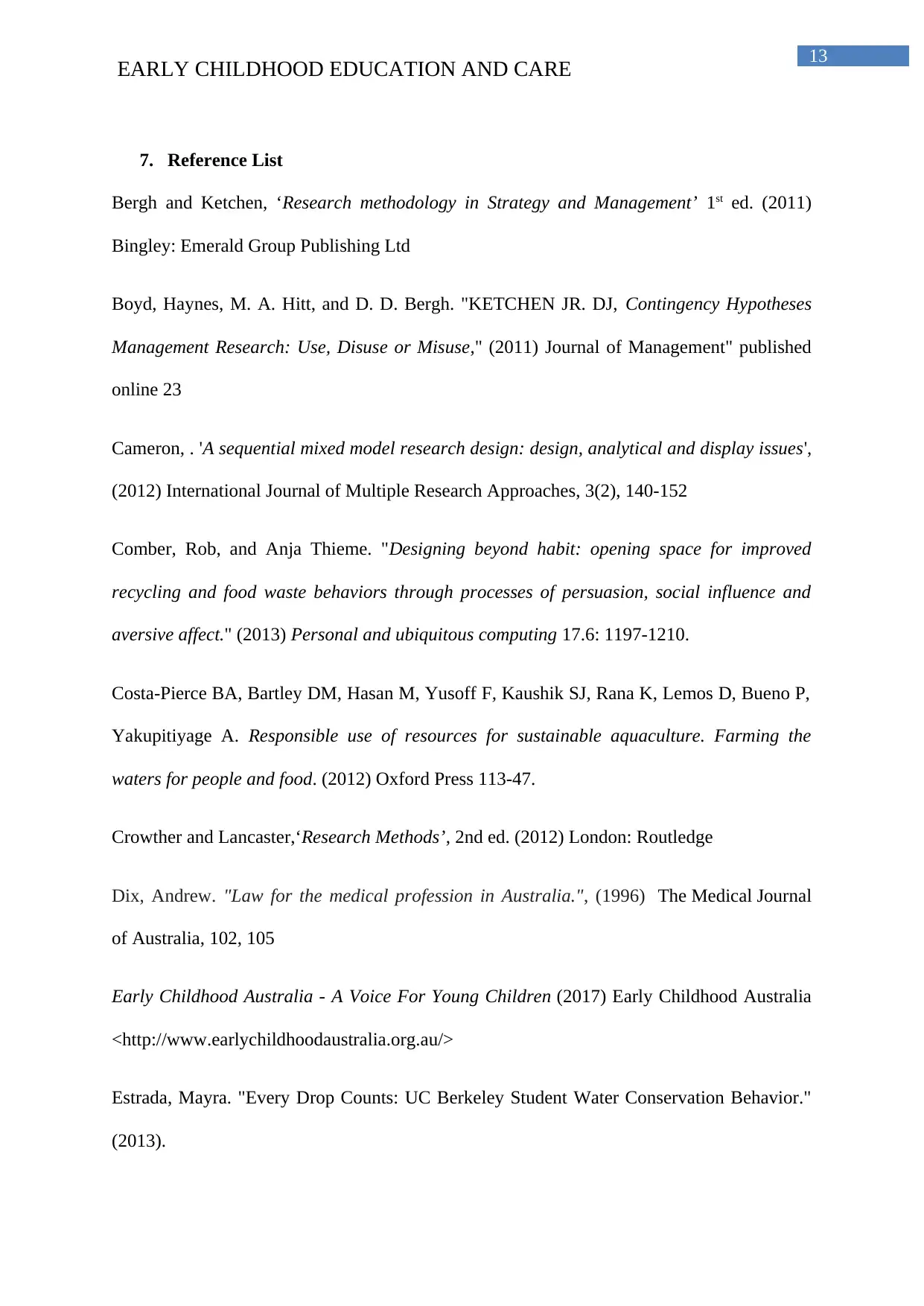
13
EARLY CHILDHOOD EDUCATION AND CARE
7. Reference List
Bergh and Ketchen, ‘Research methodology in Strategy and Management’ 1st ed. (2011)
Bingley: Emerald Group Publishing Ltd
Boyd, Haynes, M. A. Hitt, and D. D. Bergh. "KETCHEN JR. DJ, Contingency Hypotheses
Management Research: Use, Disuse or Misuse," (2011) Journal of Management" published
online 23
Cameron, . 'A sequential mixed model research design: design, analytical and display issues',
(2012) International Journal of Multiple Research Approaches, 3(2), 140-152
Comber, Rob, and Anja Thieme. "Designing beyond habit: opening space for improved
recycling and food waste behaviors through processes of persuasion, social influence and
aversive affect." (2013) Personal and ubiquitous computing 17.6: 1197-1210.
Costa-Pierce BA, Bartley DM, Hasan M, Yusoff F, Kaushik SJ, Rana K, Lemos D, Bueno P,
Yakupitiyage A. Responsible use of resources for sustainable aquaculture. Farming the
waters for people and food. (2012) Oxford Press 113-47.
Crowther and Lancaster,‘Research Methods’, 2nd ed. (2012) London: Routledge
Dix, Andrew. "Law for the medical profession in Australia.", (1996) The Medical Journal
of Australia, 102, 105
Early Childhood Australia - A Voice For Young Children (2017) Early Childhood Australia
<http://www.earlychildhoodaustralia.org.au/>
Estrada, Mayra. "Every Drop Counts: UC Berkeley Student Water Conservation Behavior."
(2013).
EARLY CHILDHOOD EDUCATION AND CARE
7. Reference List
Bergh and Ketchen, ‘Research methodology in Strategy and Management’ 1st ed. (2011)
Bingley: Emerald Group Publishing Ltd
Boyd, Haynes, M. A. Hitt, and D. D. Bergh. "KETCHEN JR. DJ, Contingency Hypotheses
Management Research: Use, Disuse or Misuse," (2011) Journal of Management" published
online 23
Cameron, . 'A sequential mixed model research design: design, analytical and display issues',
(2012) International Journal of Multiple Research Approaches, 3(2), 140-152
Comber, Rob, and Anja Thieme. "Designing beyond habit: opening space for improved
recycling and food waste behaviors through processes of persuasion, social influence and
aversive affect." (2013) Personal and ubiquitous computing 17.6: 1197-1210.
Costa-Pierce BA, Bartley DM, Hasan M, Yusoff F, Kaushik SJ, Rana K, Lemos D, Bueno P,
Yakupitiyage A. Responsible use of resources for sustainable aquaculture. Farming the
waters for people and food. (2012) Oxford Press 113-47.
Crowther and Lancaster,‘Research Methods’, 2nd ed. (2012) London: Routledge
Dix, Andrew. "Law for the medical profession in Australia.", (1996) The Medical Journal
of Australia, 102, 105
Early Childhood Australia - A Voice For Young Children (2017) Early Childhood Australia
<http://www.earlychildhoodaustralia.org.au/>
Estrada, Mayra. "Every Drop Counts: UC Berkeley Student Water Conservation Behavior."
(2013).
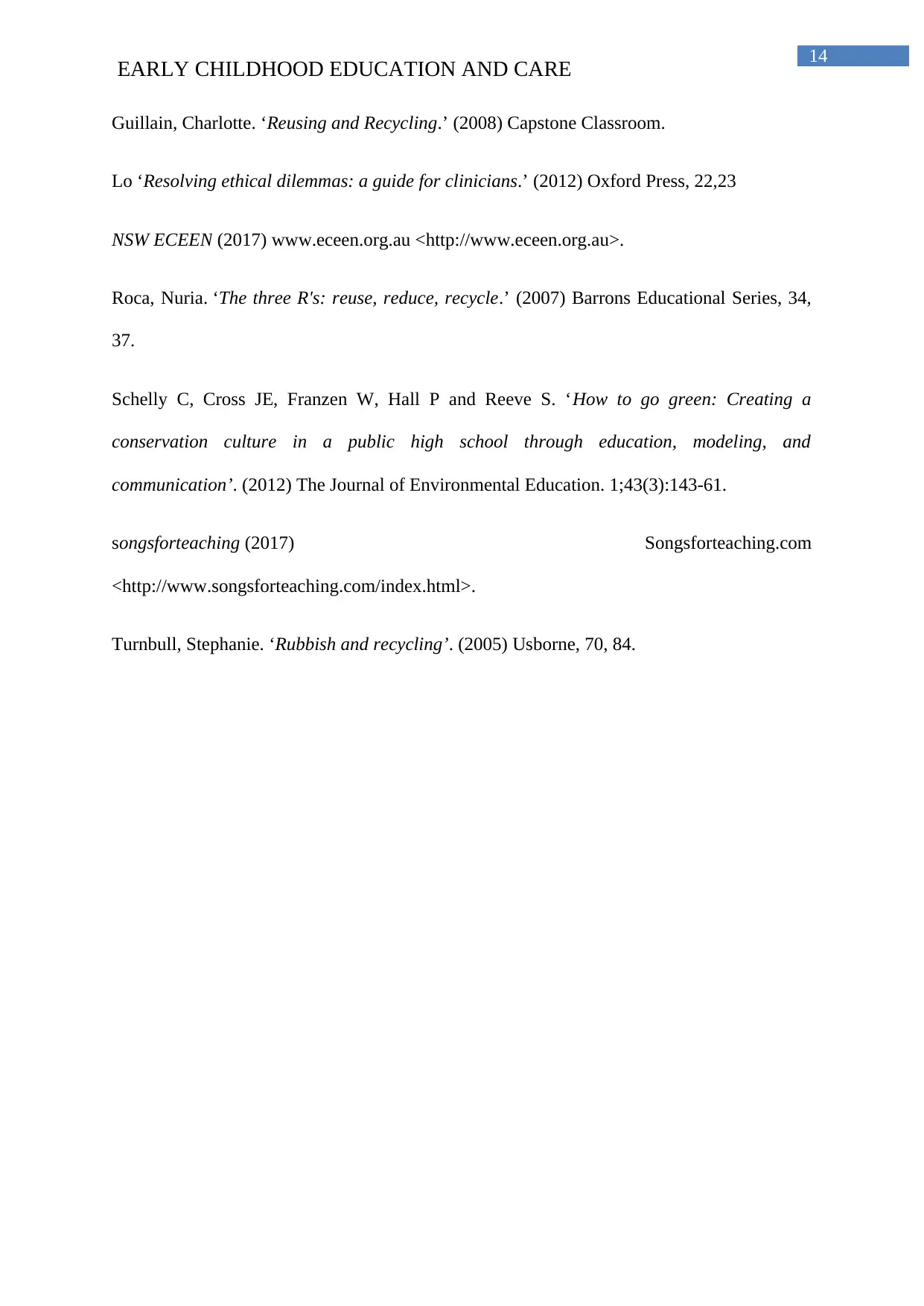
14
EARLY CHILDHOOD EDUCATION AND CARE
Guillain, Charlotte. ‘Reusing and Recycling.’ (2008) Capstone Classroom.
Lo ‘Resolving ethical dilemmas: a guide for clinicians.’ (2012) Oxford Press, 22,23
NSW ECEEN (2017) www.eceen.org.au <http://www.eceen.org.au>.
Roca, Nuria. ‘The three R's: reuse, reduce, recycle.’ (2007) Barrons Educational Series, 34,
37.
Schelly C, Cross JE, Franzen W, Hall P and Reeve S. ‘How to go green: Creating a
conservation culture in a public high school through education, modeling, and
communication’. (2012) The Journal of Environmental Education. 1;43(3):143-61.
songsforteaching (2017) Songsforteaching.com
<http://www.songsforteaching.com/index.html>.
Turnbull, Stephanie. ‘Rubbish and recycling’. (2005) Usborne, 70, 84.
EARLY CHILDHOOD EDUCATION AND CARE
Guillain, Charlotte. ‘Reusing and Recycling.’ (2008) Capstone Classroom.
Lo ‘Resolving ethical dilemmas: a guide for clinicians.’ (2012) Oxford Press, 22,23
NSW ECEEN (2017) www.eceen.org.au <http://www.eceen.org.au>.
Roca, Nuria. ‘The three R's: reuse, reduce, recycle.’ (2007) Barrons Educational Series, 34,
37.
Schelly C, Cross JE, Franzen W, Hall P and Reeve S. ‘How to go green: Creating a
conservation culture in a public high school through education, modeling, and
communication’. (2012) The Journal of Environmental Education. 1;43(3):143-61.
songsforteaching (2017) Songsforteaching.com
<http://www.songsforteaching.com/index.html>.
Turnbull, Stephanie. ‘Rubbish and recycling’. (2005) Usborne, 70, 84.
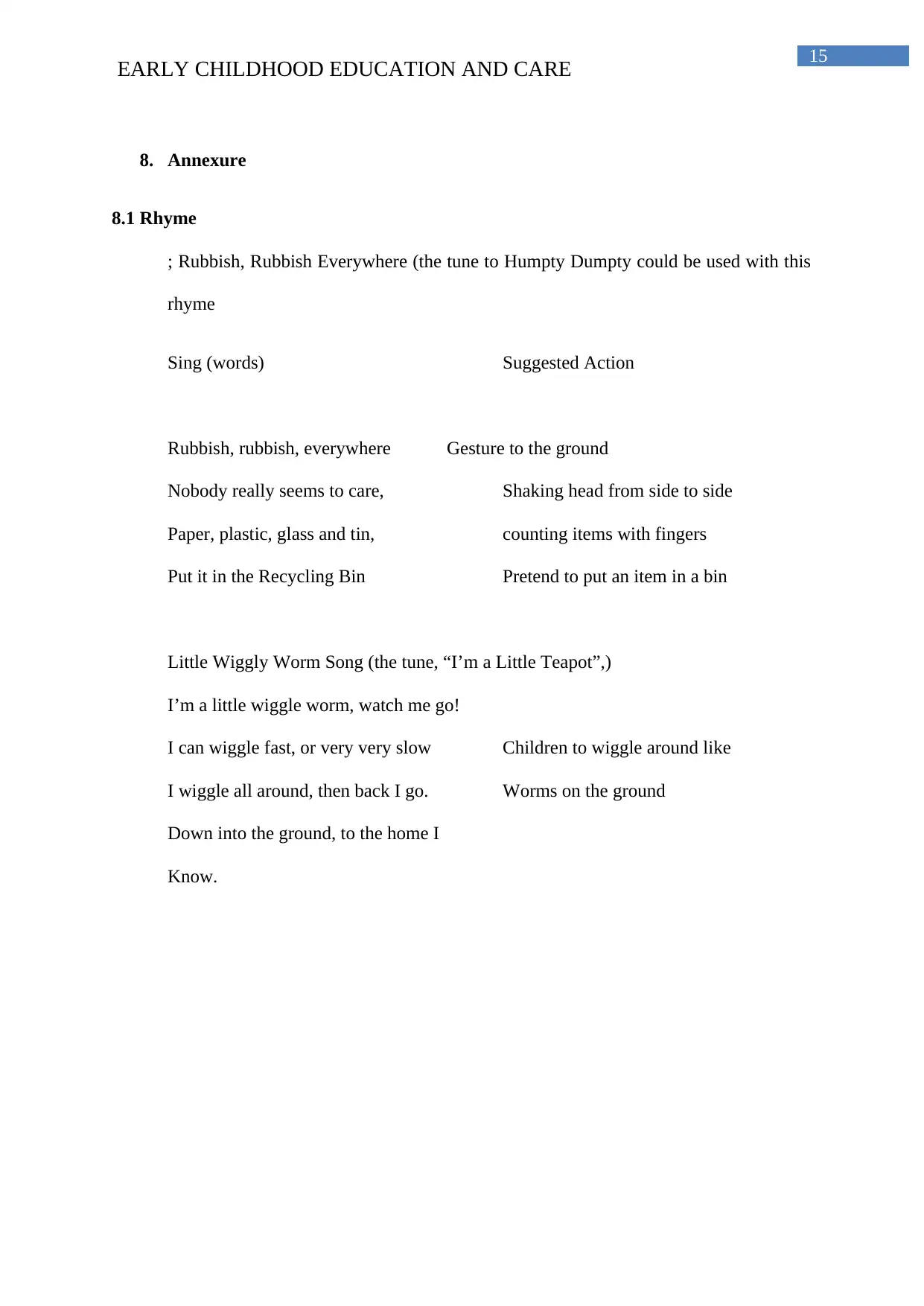
15
EARLY CHILDHOOD EDUCATION AND CARE
8. Annexure
8.1 Rhyme
; Rubbish, Rubbish Everywhere (the tune to Humpty Dumpty could be used with this
rhyme
Sing (words) Suggested Action
Rubbish, rubbish, everywhere Gesture to the ground
Nobody really seems to care, Shaking head from side to side
Paper, plastic, glass and tin, counting items with fingers
Put it in the Recycling Bin Pretend to put an item in a bin
Little Wiggly Worm Song (the tune, “I’m a Little Teapot”,)
I’m a little wiggle worm, watch me go!
I can wiggle fast, or very very slow Children to wiggle around like
I wiggle all around, then back I go. Worms on the ground
Down into the ground, to the home I
Know.
EARLY CHILDHOOD EDUCATION AND CARE
8. Annexure
8.1 Rhyme
; Rubbish, Rubbish Everywhere (the tune to Humpty Dumpty could be used with this
rhyme
Sing (words) Suggested Action
Rubbish, rubbish, everywhere Gesture to the ground
Nobody really seems to care, Shaking head from side to side
Paper, plastic, glass and tin, counting items with fingers
Put it in the Recycling Bin Pretend to put an item in a bin
Little Wiggly Worm Song (the tune, “I’m a Little Teapot”,)
I’m a little wiggle worm, watch me go!
I can wiggle fast, or very very slow Children to wiggle around like
I wiggle all around, then back I go. Worms on the ground
Down into the ground, to the home I
Know.
Secure Best Marks with AI Grader
Need help grading? Try our AI Grader for instant feedback on your assignments.
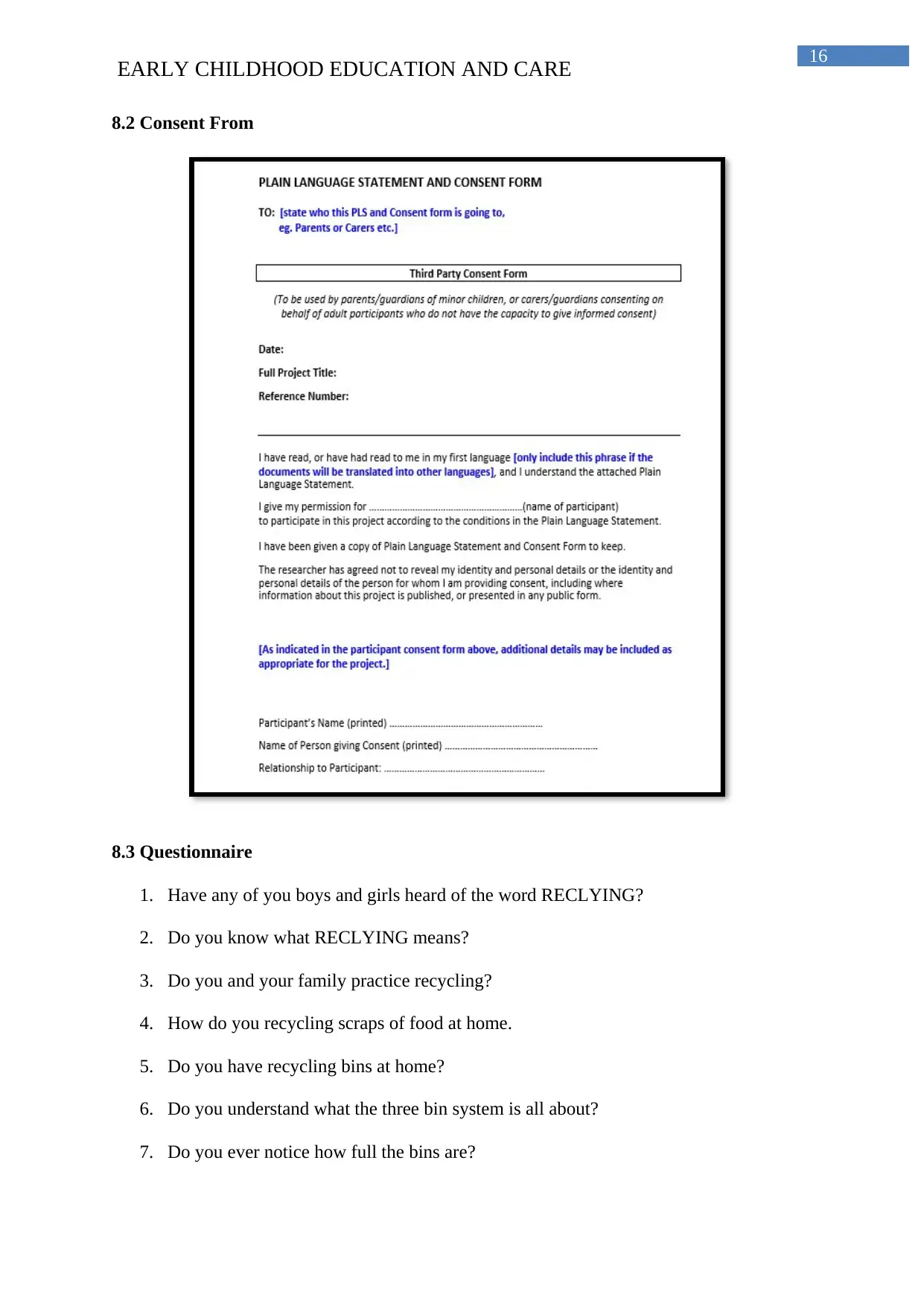
16
EARLY CHILDHOOD EDUCATION AND CARE
8.2 Consent From
8.3 Questionnaire
1. Have any of you boys and girls heard of the word RECLYING?
2. Do you know what RECLYING means?
3. Do you and your family practice recycling?
4. How do you recycling scraps of food at home.
5. Do you have recycling bins at home?
6. Do you understand what the three bin system is all about?
7. Do you ever notice how full the bins are?
EARLY CHILDHOOD EDUCATION AND CARE
8.2 Consent From
8.3 Questionnaire
1. Have any of you boys and girls heard of the word RECLYING?
2. Do you know what RECLYING means?
3. Do you and your family practice recycling?
4. How do you recycling scraps of food at home.
5. Do you have recycling bins at home?
6. Do you understand what the three bin system is all about?
7. Do you ever notice how full the bins are?
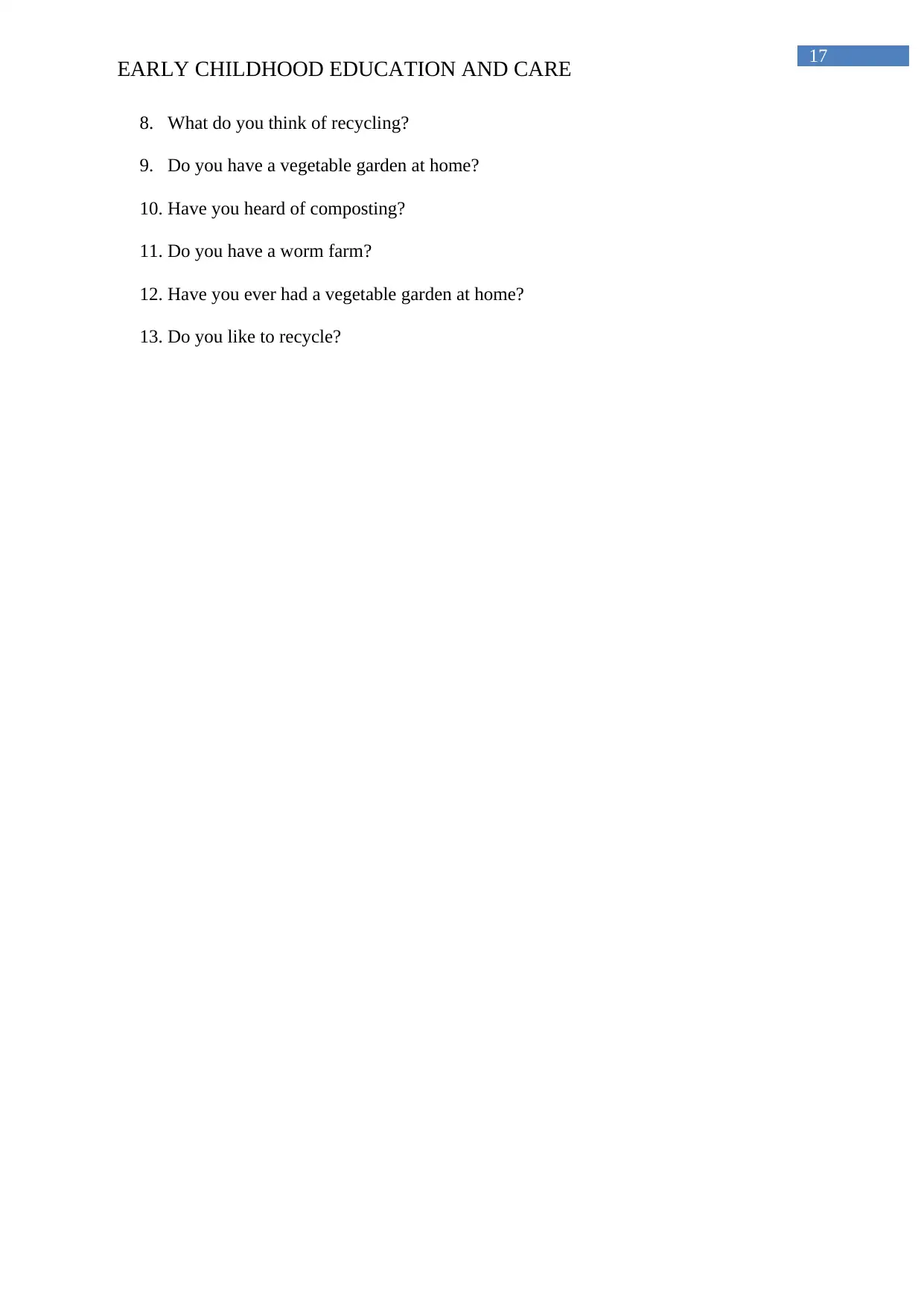
17
EARLY CHILDHOOD EDUCATION AND CARE
8. What do you think of recycling?
9. Do you have a vegetable garden at home?
10. Have you heard of composting?
11. Do you have a worm farm?
12. Have you ever had a vegetable garden at home?
13. Do you like to recycle?
EARLY CHILDHOOD EDUCATION AND CARE
8. What do you think of recycling?
9. Do you have a vegetable garden at home?
10. Have you heard of composting?
11. Do you have a worm farm?
12. Have you ever had a vegetable garden at home?
13. Do you like to recycle?
1 out of 18
Related Documents
Your All-in-One AI-Powered Toolkit for Academic Success.
+13062052269
info@desklib.com
Available 24*7 on WhatsApp / Email
![[object Object]](/_next/static/media/star-bottom.7253800d.svg)
Unlock your academic potential
© 2024 | Zucol Services PVT LTD | All rights reserved.





